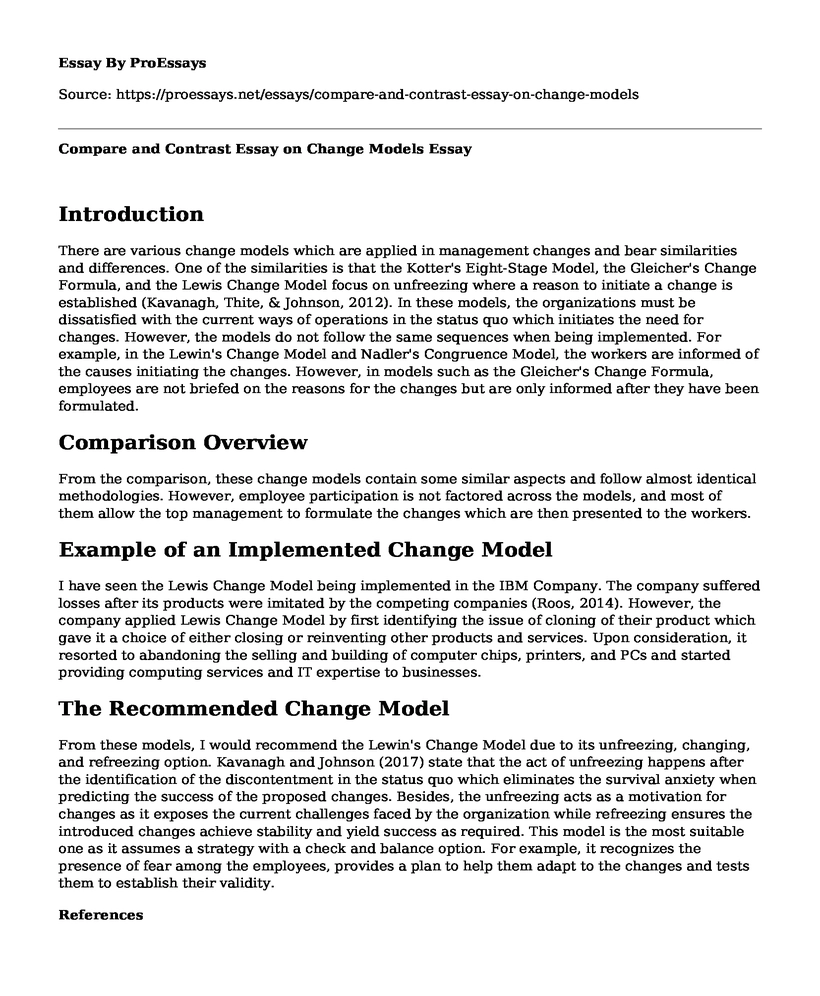Introduction
There are various change models which are applied in management changes and bear similarities and differences. One of the similarities is that the Kotter's Eight-Stage Model, the Gleicher's Change Formula, and the Lewis Change Model focus on unfreezing where a reason to initiate a change is established (Kavanagh, Thite, & Johnson, 2012). In these models, the organizations must be dissatisfied with the current ways of operations in the status quo which initiates the need for changes. However, the models do not follow the same sequences when being implemented. For example, in the Lewin's Change Model and Nadler's Congruence Model, the workers are informed of the causes initiating the changes. However, in models such as the Gleicher's Change Formula, employees are not briefed on the reasons for the changes but are only informed after they have been formulated.
Comparison Overview
From the comparison, these change models contain some similar aspects and follow almost identical methodologies. However, employee participation is not factored across the models, and most of them allow the top management to formulate the changes which are then presented to the workers.
Example of an Implemented Change Model
I have seen the Lewis Change Model being implemented in the IBM Company. The company suffered losses after its products were imitated by the competing companies (Roos, 2014). However, the company applied Lewis Change Model by first identifying the issue of cloning of their product which gave it a choice of either closing or reinventing other products and services. Upon consideration, it resorted to abandoning the selling and building of computer chips, printers, and PCs and started providing computing services and IT expertise to businesses.
The Recommended Change Model
From these models, I would recommend the Lewin's Change Model due to its unfreezing, changing, and refreezing option. Kavanagh and Johnson (2017) state that the act of unfreezing happens after the identification of the discontentment in the status quo which eliminates the survival anxiety when predicting the success of the proposed changes. Besides, the unfreezing acts as a motivation for changes as it exposes the current challenges faced by the organization while refreezing ensures the introduced changes achieve stability and yield success as required. This model is the most suitable one as it assumes a strategy with a check and balance option. For example, it recognizes the presence of fear among the employees, provides a plan to help them adapt to the changes and tests them to establish their validity.
References
Kavanagh, M. J., Thite, M., & Johnson, R. D. (2012). Human resource information systems: Basics, applications, and future directions. Thousand Oaks, Calif: SAGE.
Roos, D. (2014). 10 Companies that completely reinvented themselves. Retrieved from https://money.howstuffworks.com/10-companies-reinvented-themselves1.htm.
Cite this page
Compare and Contrast Essay on Change Models. (2022, Nov 08). Retrieved from https://proessays.net/essays/compare-and-contrast-essay-on-change-models
If you are the original author of this essay and no longer wish to have it published on the ProEssays website, please click below to request its removal:
- Introduction to Ethics in Decision Making
- Marketing Strategies to Sensitize Organ Donation in Portugal Essay
- Strategic Management Paper Example: Case Study Analysis on Amazon
- Essay on Competing for Talent in a Tightening Market: Talent Management Strategies
- Essay Example on Organizational Culture: A Key Factor in Success and Fraud
- Essay Sample on Fully-Functioning Mobile Apps: The Future of Sales
- Labor Formation Comparison: Germany vs USA - Free Essay Sample







